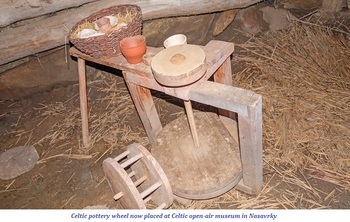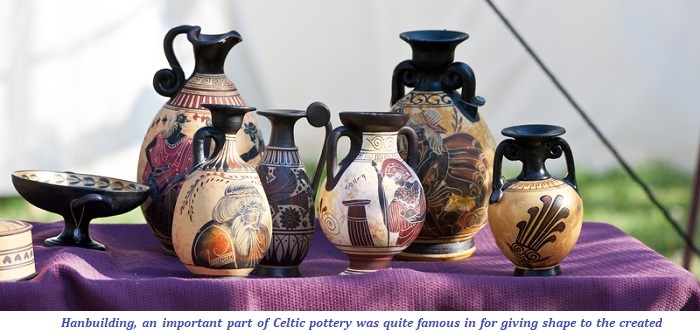

Ancient Celtic pottery refers to the pottery made by the Celtic people during the Iron Age (c. 800 BCE - 43 CE) in Europe. The Celts were a group of Indo-European peoples who spoke Celtic language.
Celtic pottery required various techniques to do the pottery, including wheel-thrown, coil, and slab construction. The pottery was fired in kilns and decorated using different methods, such as incising, stamping, and painting. Celtic pottery was functional and important to Celtic religious and cultural practices.
Ancient Celtic pottery provides insight into the Celtic people's material culture and artistic expression. Today, many examples of Celtic pottery can be found in museums and private collections worldwide, providing a glimpse into this ancient civilization's rich history and Celtic people.
Ancient Celtic pottery first came into existence with the help of Celtic people, who lived in Europe during the Iron Age and early Mediaeval period. The Celtic people started to use Celtic wheel very early. Here are some of the characteristics of their ancient Celtic pottery −
who lived in Europe during the Iron Age and early Mediaeval period. The Celtic people started to use Celtic wheel very early. Here are some of the characteristics of their ancient Celtic pottery −
Handmade − Most Celtic potteries were made by hand using simple tools and techniques, such as coiling and pinching
Organic shapes − Celtic pottery often had organic shapes with curves and uneven surfaces. Bowls and cups were common forms. The Celtic people also made jars and amphorae for storage and transportation.
Decorative motifs. − Celtic pottery's decoration is noticeable. The Celtic people often decorated the Celtic pottery with intricate designs, spirals, geometric patterns, and animal motifs. These were sometimes incised or painted onto the surface of the pottery
Earthenware − The Celtic people made Celtic pottery from earthenware, a type of clay fired at a low temperature. The earthenware made it more porous and less durable than other types of pottery.
Burnished surface − People finished some Celtic pottery with a burnishing technique. It involved rubbing the surface of the pottery with a smooth object to create a shiny, polished effect.

Techniques and processes used in producing Celtic pottery varied depending on the region and period. Here are some standard features characterising Celtic pottery.
Coiling − One of the main techniques used in Celtic pottery is coiling. It involves the creation of a long, thin roll of clay, which is then coiled around itself to form the vessel's shape. The coils then get smoothed together to create a solid wall.
Handbuilding − Another common technique used in Celtic pottery is hand-building. It involves shaping the vessel by hand, using techniques such as pinching and paddling to create the desired shape.
Decoration − Celtic people often decorated the Celtic pottery with intricate designs using various techniques. Some standard decoration techniques include incising, where a design gets cut into the surface of the clay and stamping, where a pattern is impressed into the clay using a stamp.
Firing − Celtic pottery gets fired in kilns, coming from clay and brick. The firing process was typically done at high temperatures, resulting in a complex, durable surface that was water-resistant.
Glazing − Some Celtic pottery was glazed, which involved the application of a liquid mixture of clay and other materials to the vessel's surface. Glazes were typically applied before firing and could be used to create a variety of colours and textures.
Clay − The type of clay used in Celtic pottery varied depending on the region and period. However, a common type of clay included red earthenware clay. People found them in the southern and eastern parts of Europe. Sandy clay was also available in the northern parts of Europe.
Ancient Celtic pottery provides valuable insights into the artistic, technological, and cultural achievements of the Celtic people, who were one of Europe's most significant and widespread cultural groups during the Iron Age. Here are some of the critical reasons why ancient Celtic pottery is significant −
Cultural insights − Celtic pottery can provide essential clues about the beliefs, customs, and lifestyles of the Celtic people, such as their religious practices, social structures, and economic activities.
Artistic expression − Celtic pottery came with intricate patterns and designs that reflected its makers' creativity and artistic skill. These designs can also provide insights into the cultural and religious symbolism of the Celts.
Technological advancement − The techniques used to make Celtic pottery, such as wheel-throwing and kiln-firing, were highly advanced and represented significant technological achievements in ceramics.
Historical significance − Studying ancient Celtic pottery can shed light on the historical interactions between the Celtic people and other cultures and their migrations, trade networks, and political alliances
Preservation − Celtic pottery has survived for thousands of years and provides a tangible link to the past, allowing us to connect with the people who made and used it and learn from their achievements and experiences.
Ancient Celtic Pottery is a fascinating subject that sheds light on the artistic and technological capabilities of the Celtic people. Celtic pottery also played an essential role in trade and commerce. As it was exported throughout Europe, it influenced the pottery styles of neighbouring cultures. Overall, studying Ancient Celtic Pottery is a crucial aspect of understanding the rich cultural heritage of the Celtic civilization.
Q1. How did Celtic pottery influence other countries?
Ans. People who made Celtic pottery made a lot of things for transportation and business. This was how things made of Celtic pottery spread throughout the world. Eventually, it started impacting other countries and cultures.
Q2. What were some of the techniques used to create Celtic pottery?
Ans. Celtic potters used various techniques to create their pottery, including hand-building using coils or slabs, wheel-throwing, and mould-casting. They also used various firing techniques, including pit firing and kiln firing.
Q3. Is Celtic pottery still being produced today?
Ans. While the ancient Celtic people no longer exist, potters still create pottery inspired by Celtic designs and techniques. These potters may use modern materials and tools but often draw on traditional Celtic motifs and styles. So, yes. They are still famous.